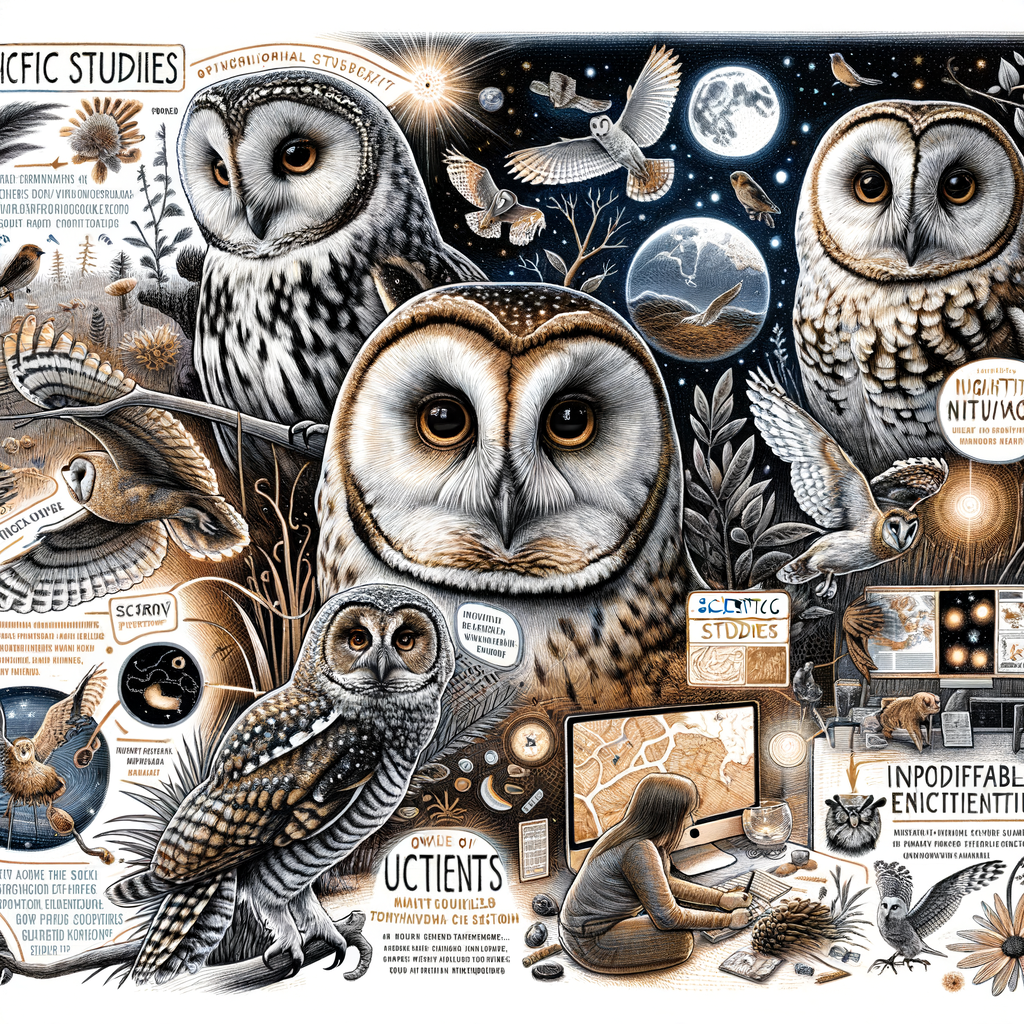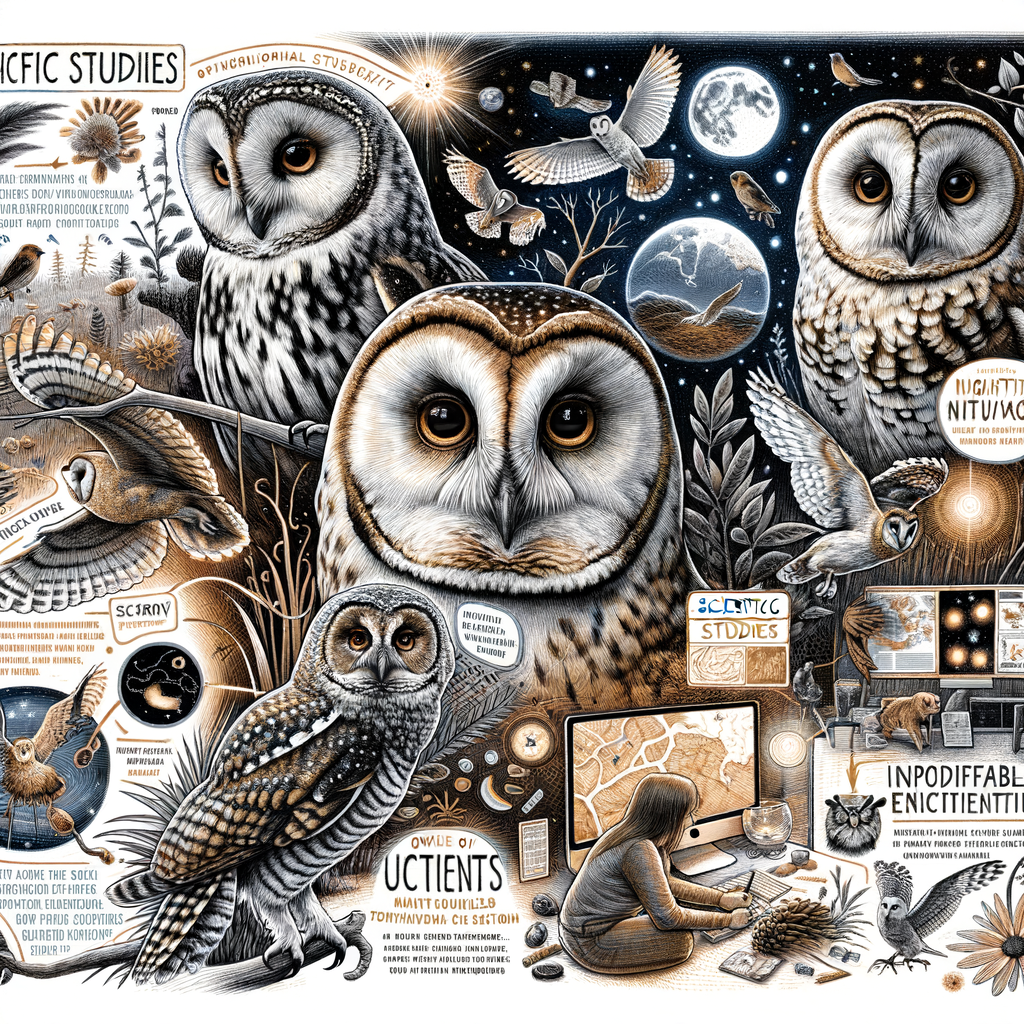
Owls in Scientific Studies: An Overview
-
Introduction to Owl Research
Owls are fascinating birds that have captured the interest of scientists for many years. They are known for their unique abilities, such as silent flight and excellent night vision. Researchers study owls to learn more about these amazing traits and how they help owls survive in the wild.
-
Importance of Studying Owls
First, it helps us understand their role in the ecosystem. Owls are predators that help control the population of small animals like mice and insects. Second, research on owls can lead to discoveries that benefit humans, such as new technologies inspired by owl flight and vision.
-
Historical Perspective of Owl Studies
Ancient civilizations, like the Greeks, admired owls and associated them with wisdom. In modern times, scientists have used advanced tools to study owls more closely. For example, they use tracking devices to learn about owl migration patterns and cameras to observe their behavior in the wild.
Owl Behavior Research
Owl Behavior
- Study of owl behavior patterns: Researchers study these patterns to understand how owls hunt, communicate, and interact with their environment. For example, owls have a special way of turning their heads almost all the way around, which helps them see better in the dark.
- Insights into nocturnal behavior of owls: Owls are mostly active at night, which is called being nocturnal. They have excellent night vision and can hear very well. This helps them find food in the dark. Scientists have found that owls can hear even the smallest sounds, like a mouse moving in the grass, from far away.
Case Studies on Owl Behavior
-
Case Study 1: Hunting Patterns of Barn Owls
Researchers observed barn owls in a rural area. They found that these owls hunt mostly at night. The study showed that barn owls use their excellent hearing to locate prey in the dark. They can catch mice and other small animals even in complete darkness.
Key Insights:
- Barn owls hunt mainly at night.
- They rely on their hearing to find prey.
- They can hunt in total darkness.
For more information, you can read about Barn Owls on Wikipedia.
-
Case Study 2: Social Behavior of Snowy Owls
In another study, scientists looked at the social behavior of snowy owls. They found that snowy owls are usually solitary. However, during the breeding season, they form pairs and work together to raise their young. This study also noted that snowy owls are very protective of their nests.
Key Insights:
- Snowy owls are mostly solitary.
- They form pairs during breeding season.
- They are protective of their nests.
For more information, you can read about Snowy Owls on Wikipedia.
Owl Species Analysis
Classification of Owl Species
- Overview of different owl species:Owls are fascinating birds with over 200 species worldwide. They belong to the order Strigiformes, which is divided into two families: Tytonidae (barn owls) and Strigidae (true owls).
Each species has unique features and behaviors. For example, the Great Horned Owl is known for its distinctive ear tufts, while the Snowy Owl is famous for its white plumage.
- Traits of different owl species:Owls have many unique traits that help them survive. Their large eyes and facial discs help them see and hear better at night. Some species, like the Barn Owl, have heart-shaped faces that improve their hearing.
Another interesting trait is their ability to rotate their heads up to 270 degrees. This helps them spot prey without moving their bodies. The Elf Owl, one of the smallest species, is known for its agility and can catch insects in mid-air.
Comparative Analysis of Owl Species
-
Comparative Study 1: Barn Owl vs. Great Horned Owl
The Barn Owl and the Great Horned Owl are two well-known species. They have different habitats and hunting styles.
Feature Barn Owl Great Horned Owl Size Medium Large Habitat Open fields and farms Forests and deserts Diet Small mammals Varied, including mammals and birds Hunting Style Silent flight Powerful talons According to Wikipedia, Barn Owls are known for their heart-shaped faces and silent flight. In contrast, Great Horned Owls have a more varied diet and are known for their strong talons.
-
Comparative Study 2: Snowy Owl vs. Burrowing Owl
Snowy Owls and Burrowing Owls are unique in their own ways. They live in very different environments and have distinct behaviors.
Feature Snowy Owl Burrowing Owl Size Large Small Habitat Arctic tundra Grasslands and deserts Diet Rodents and birds Insects and small mammals Behavior Daytime hunting Lives in burrows As noted in Wikipedia, Snowy Owls are adapted to cold climates and are active during the day. Burrowing Owls, on the other hand, live in warmer areas and are known for their unique habit of living in burrows.
Owl Habitat Studies
Owl Habitats
- Common habitats of owls: Owls can be found in many different habitats around the world. They live in forests, deserts, mountains, and even cities. For example, the Barn Owl often lives in open fields and farms, while the Snowy Owl prefers the cold Arctic tundra.
- Adaptation of owls to different habitats: Owls have special features that help them survive in their habitats. Their feathers are designed for silent flight, which helps them hunt at night. Some owls, like the Great Horned Owl, have powerful talons to catch prey in dense forests. Others, like the Burrowing Owl, live in underground burrows to stay safe from predators.
Nocturnal Birds Research
Comparative Study of Nocturnal Birds
- Comparison of Owls with Other Nocturnal Birds: Owls are often compared to other nocturnal birds like nightjars and nighthawks. Owls have large eyes and a facial disk that helps them hear better. Nightjars and nighthawks, on the other hand, have smaller eyes and rely more on their sense of smell.
- Traits of Nocturnal Birds: Nocturnal birds have special traits that help them survive at night. For example, many have excellent night vision and silent flight. Owls have feathers that muffle sound, making them silent hunters. Other nocturnal birds, like the kiwi, have a strong sense of smell to find food in the dark.
| Bird | Special Trait | Example |
|---|---|---|
| Owl | Silent flight | Great Horned Owl |
| Nightjar | Camouflage | Common Nightjar |
| Kiwi | Strong sense of smell | North Island Brown Kiwi |
According to Wikipedia, owls have evolved to be top nocturnal predators. Their unique traits make them fascinating subjects for research.
Owl Physiology Research
Owl Physiology
Owls are fascinating creatures with unique physical features. Scientists study these features to understand how owls live and thrive, especially at night.
- Study of owl anatomy: Owls have special body parts that help them hunt and survive. For example, their large eyes help them see in the dark. Their sharp talons and beaks are perfect for catching prey.
- Adaptations of owls for nocturnal life: Owls are night hunters. They have special adaptations like silent flight, which helps them sneak up on prey. Their feathers are soft, which reduces noise when they fly. This makes them excellent hunters in the dark.
| Feature | Function |
|---|---|
| Large Eyes | Help see in low light |
| Sharp Talons | Catch and hold prey |
| Silent Flight | Allows sneaking up on prey |
| Soft Feathers | Reduce noise during flight |
These features helps scientists learn more about how owls live and hunt. This research is important for protecting owl species and their habitats.
Ecological Impact of Owls
Owls in Ecosystem Research
- Role of owls in the ecosystem: They are top predators and help control the population of small mammals, birds, and insects. This keeps the food chain balanced and prevents overpopulation of certain species.
- Impact of owls on prey populations: By preying on rodents and other small animals, owls help reduce the spread of diseases. For example, fewer rodents mean fewer ticks, which can carry Lyme disease. This makes owls important for both ecosystem health and human health.
| Aspect | Details |
|---|---|
| Predator Role | Control populations of small mammals, birds, and insects |
| Disease Control | Reduce the spread of diseases like Lyme disease |
| Food Chain Balance | Prevent overpopulation of certain species |
According to a study published on Wikipedia, owls are vital for the health of many ecosystems. They help keep the environment stable and healthy.
Owl Predation Studies
-
Predation Study 1
A study conducted in 2018 observed the hunting habits of the Barn Owl. Researchers found that Barn Owls primarily hunt small mammals like mice and voles. Over a period of six months, they recorded that each owl caught an average of 3 to 4 prey items per night.
Key insights from the study include:
- Prey Selection: Barn Owls prefer small mammals over insects.
- Hunting Time: Most hunting occurs between dusk and midnight.
According to the study, Barn Owls play a crucial role in controlling rodent populations, which can help farmers protect their crops.
-
Predation Study 2
In another study from 2020, scientists focused on the Great Horned Owl. This study revealed that Great Horned Owls have a more varied diet compared to Barn Owls. They hunt not only small mammals but also birds, reptiles, and even other owls.
Important findings from this study include:
- Diet Diversity: Great Horned Owls have a broader diet, which helps them adapt to different environments.
- Hunting Techniques: They use a mix of perch hunting and flight hunting to catch their prey.
The study concluded that Great Horned Owls are apex predators in their habitats, meaning they are at the top of the food chain and have no natural predators.
Owl Conservation Science
Threats to Owl Populations
- Overview of threats to owls: Owls face many dangers in the wild. These can come from natural predators, loss of habitat, and climate change. Each of these threats can make it hard for owls to find food and safe places to live.
- Impact of human activities on owls: Human actions have a big effect on owls. For example, cutting down trees destroys their homes. Pollution can poison their food and water. Roads and buildings can make it hard for owls to travel and find mates.
| Threat | Impact |
|---|---|
| Habitat Loss | Owls lose their homes and hunting grounds. |
| Climate Change | Alters the availability of prey and suitable nesting sites. |
| Pollution | Contaminates food and water sources, leading to health issues. |
| Human Development | Creates barriers that disrupt owl movement and breeding. |
According to Wikipedia, owls are vital for controlling rodent populations. Protecting them is crucial for maintaining ecological balance.
Conservation Efforts for Owls
- Habitat ProtectionOne of the most important conservation efforts is protecting the habitats where owls live. Many owls need large areas of forest to hunt and nest. By preserving these forests, we help ensure that owls have a safe place to live.
For example, the Spotted Owl in North America has benefited from protected forest areas. These efforts help maintain the population of this endangered species.
- Breeding ProgramsAnother key effort is breeding programs. These programs help increase the number of owls in the wild. Scientists carefully breed owls in captivity and then release them into safe environments.
For instance, the Barn Owl has seen success through these programs. By increasing their numbers, we can help balance the ecosystem.
| Conservation Effort | Details |
|---|---|
| Habitat Protection | Preserving forests and natural habitats to provide safe living spaces for owls. |
| Breeding Programs | Breeding owls in captivity and releasing them into the wild to boost population numbers. |






